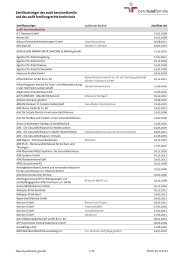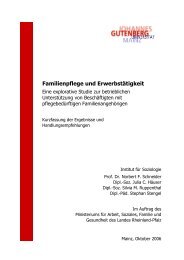Perspektive Wiedereinstieg - Beruf & Familie gGmbH
Perspektive Wiedereinstieg - Beruf & Familie gGmbH
Perspektive Wiedereinstieg - Beruf & Familie gGmbH
Sie wollen auch ein ePaper? Erhöhen Sie die Reichweite Ihrer Titel.
YUMPU macht aus Druck-PDFs automatisch weboptimierte ePaper, die Google liebt.
Ten percent of the interviewed women could imagine starting up a professional selfemployment;<br />
the percentage of participating women is higher here.<br />
How do employment rates develop over time? It should be kept in mind that, compared to<br />
nonparticipants, participants would probably have remained withdrawn from the labor<br />
market for a longer period of time without the help of the program. Participating women as<br />
well as nonparticipating women who have taken up a new job are mostly working parttime<br />
or marginal parttime. Depending on the time of the survey, about 50 to 70 percent of the<br />
interviewees have been working in a fulltime job, parttime or in a minor employment.<br />
During all interviews, however, only about ten percent of the women have been working fulltime.<br />
Over time, the percentage of women working fulltime or parttime increased from<br />
about 30 to 50 percent. A comparison with “statistical twins” from the potential comparison<br />
group – women who are clients of the Federal Employment Agency – shows that even though<br />
the target group of the program consists of women with a rather low labor market orientation<br />
(starting application activities usually after a longer orientation period), the employment rate<br />
at the respective survey timepoint shows little variation between both groups. The employment<br />
rate of participating women who had already completed their casemanagement was<br />
often higher than in the control group; especially during the first survey wave more participating<br />
women were employed in fulltime or parttime. During the third survey wave of the first<br />
cohort (after nearly all participating women had finished their casemanagement) participants<br />
work insignificantly more frequently in a fulltime or a parttime job than comparison persons.<br />
This could indicate that positive program effects arise mainly in the longer run. Looking<br />
at the kind of help provided, in particular active support to find a job had a positive effect on<br />
the employment rate. Finally an analysis of occupational characteristics shows that parttime<br />
workers, especially “Minijobbers”, wish to work longer hours, while fulltime workers would<br />
like to reduce their working hours. Participating women are significantly less often working in<br />
jobs for which they are overqualified. Ten percent of the interviewed women were selfemployed<br />
at the time of survey.<br />
The findings of the qualitative study are based on several data sources. The key elements are<br />
30 biographical narrative (indepth) interviews with participating women of “perspective<br />
reentry” as well as a group discussion with selected experts on the topic of caring for persons<br />
who are in need of care. Furthermore, relevant professional meetings have regularly been<br />
scientifically accompanied and minuted. Public relation documents of the responsible institutions<br />
were analyzed regarding different aspects as well.<br />
In the biographical narrative interviews with 30 women potentially re-entering the labor market,<br />
traditional gender roles become apparent – not only on the part of the partner and the<br />
particular livingmilieus but also on the part of the women themselves. Thus, an important<br />
part of the work of service providers is to help women questioning these roles. A major reason<br />
for the employment interruption and its length – the birth and care of children – has been<br />
shaped by perceptions about the role of a mother and a life for the family. But structural reasons<br />
(closure of companies, moves, worktime schedules in specific sectors or jobs etc.) as well<br />
as caring for needy family members impede a reentry to the labor market.
















